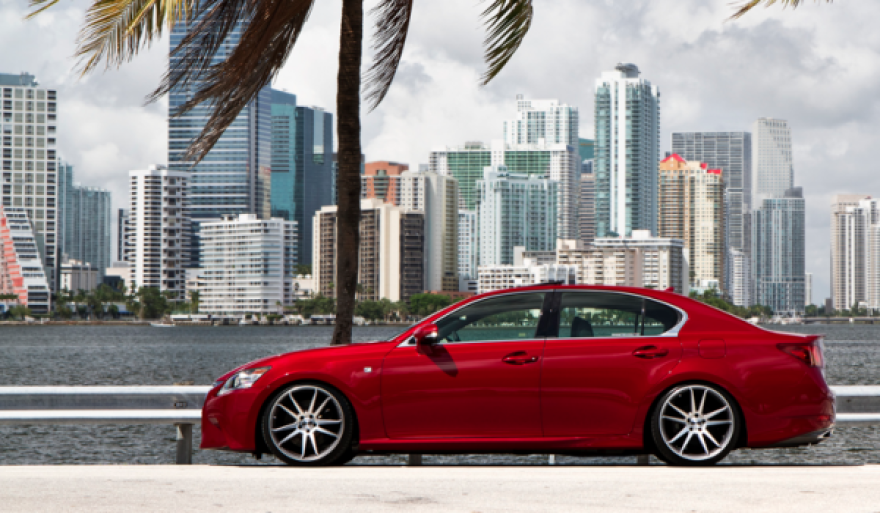There is nothing worse than a three paragraph preamble to a listicle. So all you need to know for this, in case you haven’t been following our End of the Road series, is that WLRN spent the last year doing stories about the final 87 miles of Interstate 95 -- the South Florida stretch. We’ve learned some very useful/strange things along the way.
Please enjoy the following facts for personal use and distribution while attending local cocktail and dinner parties.

1. The “closed” signs on 95 Express are the wrong colors.
You know how the Florida Department of Transportation sometimes puts the word “closed” where they normally put a toll? It’s a black sign and “closed” is written in yellow lights.
“The sign has to be black and white to be a regulatory sign,” says Lieutenant Michael Wilfong, who coordinates the Florida Highway Patrol for 95 Express. “So there’s no real enforcement of that request to not go in that lane.”
FDOT officials say they will eventually replace the yellow-and-black signs with the right color scheme, but the new Broward lanes will have the same old “request to not go in that lane” color scheme.
2. Hybrid drivers, enjoy those free rides in the express lane while you can.
FDOT says the 95 express hybrid exemption is not long for this world. Even though there are no numbers to show this happening yet, FDOT’s Jennifer Fortunas says one of the concerns is that free-riding hybrids might take over the express lanes and clog up the system:
“You are moving vehicles more efficiently which then means that you would have reduced emissions just because you’re not having lots of vehicles sit in traffic.”
Hybrid drivers still have some time. The Miami-Dade County 95 express lanes and the soon-to-come Broward County lanes will allow free rides until September of 2017. (Worth noting: You have to register for a special sticker that lets you use the lanes for free.)
3. The “godfather” of the express lanes never bought a Lexus, precisely because people started calling his express lanes “Lexus Lanes.”

The 95 express lanes are an example of dynamic tolling. Tolls go up if too many cars get into the express lanes. Higher prices scare off some drivers. Free-flowing traffic is restored.
Much of the credit for this concept is given to Robert Poole, director of transportation policy at a Libertarian think-tank called Reason Foundation.
In the mid 1990s, as departments of transportation across the country started to look at dynamic tolling for their roads, people started called Poole’s express lanes “Lexus Lanes” because they thought of it as a special highway for rich people.
The critique got under Poole’s skin enough to affect his buying habits. He consciously never bought a Lexus. “For a long time I was concerned about not having people be able to typecast me, ‘Oh, he’s just one of those people who drives a Lexus and doesn’t care about anybody else,’” Poole says.
The name Lexus Lanes doesn’t bother Poole anymore. But when he finally did buy a luxury car, it was an Infiniti.
4. I-95 had a massive drug problem.
In the 1970s, 90 percent of marijuana being smuggled into the U.S. came in through Florida. “You couldn’t get high in America without touching something that traveled on that particular stretch of asphalt,” says author Tony Dokoupil.
“So many people were driving dope up I-95 that it began to be talked about as the reefer express,” Dokoupil adds. “And so many of those people who were driving that dope were doing cocaine -- and a lot of cocaine -- that they started describing their lines as ‘lines as long as I-95.’”

5. I-95 road debris is way weirder than you think.
You’ve seen flying mattresses and disembodied bumpers, but when we asked maintenance crews for a list of the junk they’ve found on the side of I-95, it was... I don’t even know. It was just weird. As we wrote back in September:
There were toilets, sex toys and “gun bullets.” Abandoned boats and trailers, which the contractor lets law enforcement handle. There was at least one wedding dress, one tuxedo and a pair of underwear. Condoms, make up and love letters. Money (both U.S. currency and foreign). Furniture (including dressers, a sofa, a desk and a chair). Tampons. Roofing materials. Hazardous waste. Shoes. Pants. Santeria paraphernalia. Destroyed mobile devices (iPad, iPod, cell phones etc.)... And, the oddly unsettling: dental implants.
More traditional refuse included house doors and windows. Garage doors. Refrigerators. Air conditioner units. A car door. Car bumpers. A car hood. A car roof.
Basically enough junk to build your own garage. And then also build a car to put in that garage.

6. South Florida drivers really don’t care about those plastic poles that separate the I-95 express lanes from the regular lanes.
FDOT has to replace each of those plastic delineators an average of six to eight times a year.
According to Jason Chang, one of the designers of 95 Express, FDOT initially thought a pole every 20 feet would get the message across.
“We really didn’t think people driving at a certain speed... would actually try to get through them,” Chang says. “And that’s what they did in the first week. So we had to shorten that space to ten feet.”
(More pole-bashing stats here, in case you’re interested. For example, replacing those things costs FDOT around $1 million a year.)





